Food and art are ubiquitous entities within any culture. Both incite the senses and provide nourishment for the body and mind. Both are derived from particular traditions, passed down from various generations with successive additions and alterations made with each iteration. Both involve creativity and mastery at the highest levels, and yet both are common within our homes and our daily lives. Considering the prevalence of food and art and the status of each as markers of culture, it is no wonder that artists throughout the ages have ruminated on food in their practices.
This contemplation of the form and function of food provides the basis of the exhibition “Off the Menu: Looking at Food,” currently on view at the UK Art Museum. In particular, this show gathers together a variety of different works by artists from across the country and spanning a wide range of ages and abilities—from school children to world-famous masters—to explore the complex issues that arise when we consider deeply the role of food in our world today. While we consume food on a daily basis by necessity, we may not often consider how the food we prepare and eat exists within larger systems; by looking at food practices in art, we can attend to the more subtle aspects of food as an expression of our identities.
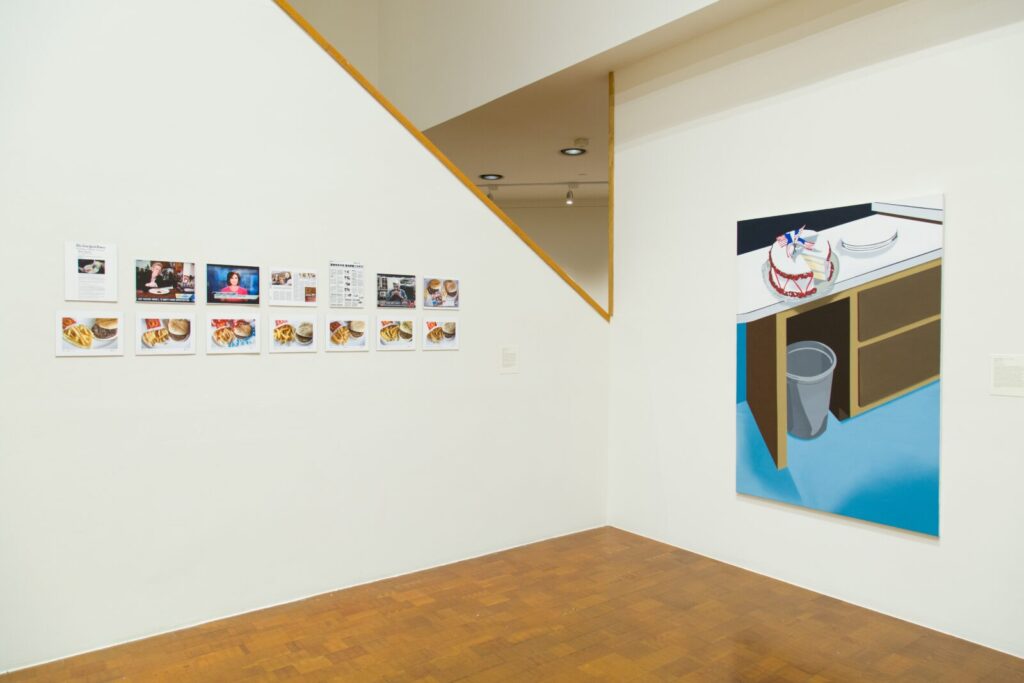
While the show is organized around the idea of how food and art are generally intertwined, the exhibition offers a particular snapshot of 20th and 21st century notions of food and food practices within the United States. In particular, the exhibition focuses on the politics of preparation, commodification, and consumption within our lives today. Bringing together artists from across the country – including a considerable number of local artists of a variety of ages – this exhibition highlights the ways in which food is central to who we are as humans, while also demonstrating how what we eat shapes and is shaped by the culture in which we exist.
Desire is central to how and what we eat. While we need food to sustain our lives, we crave food to nourish and comfort ourselves. It is this process of desire that is central to Julia Jacquette’s paintings. In particular, Jacquette explores the force of explicitly capitalist desire in her series “If I Could Only,” an 8-panel polyptych in which she juxtaposes the phrase “If I could only touch your perfect body” with aestheticized images of mid-century American dishes, like meatloaf and ice cream sundaes. These dishes, sourced from vintage publications including Life, Ladies Home Journal, and The Saturday Evening Post, are clearly designed for presentation—trimmed with an excessive amount of garnish and decoration and cleanly arranged on particular serving dishes—and appear visually perfect, and thus desirable. The words thus highlight the subtext of these mass cultural images of food, stating clearly how they are meant to stoke our desire as consumers, both literally and figuratively. In so doing, she makes apparent the way that advertisements and other works of mass culture conflate sexual desire with consumption, highlighting the coercive forces that make us want food.
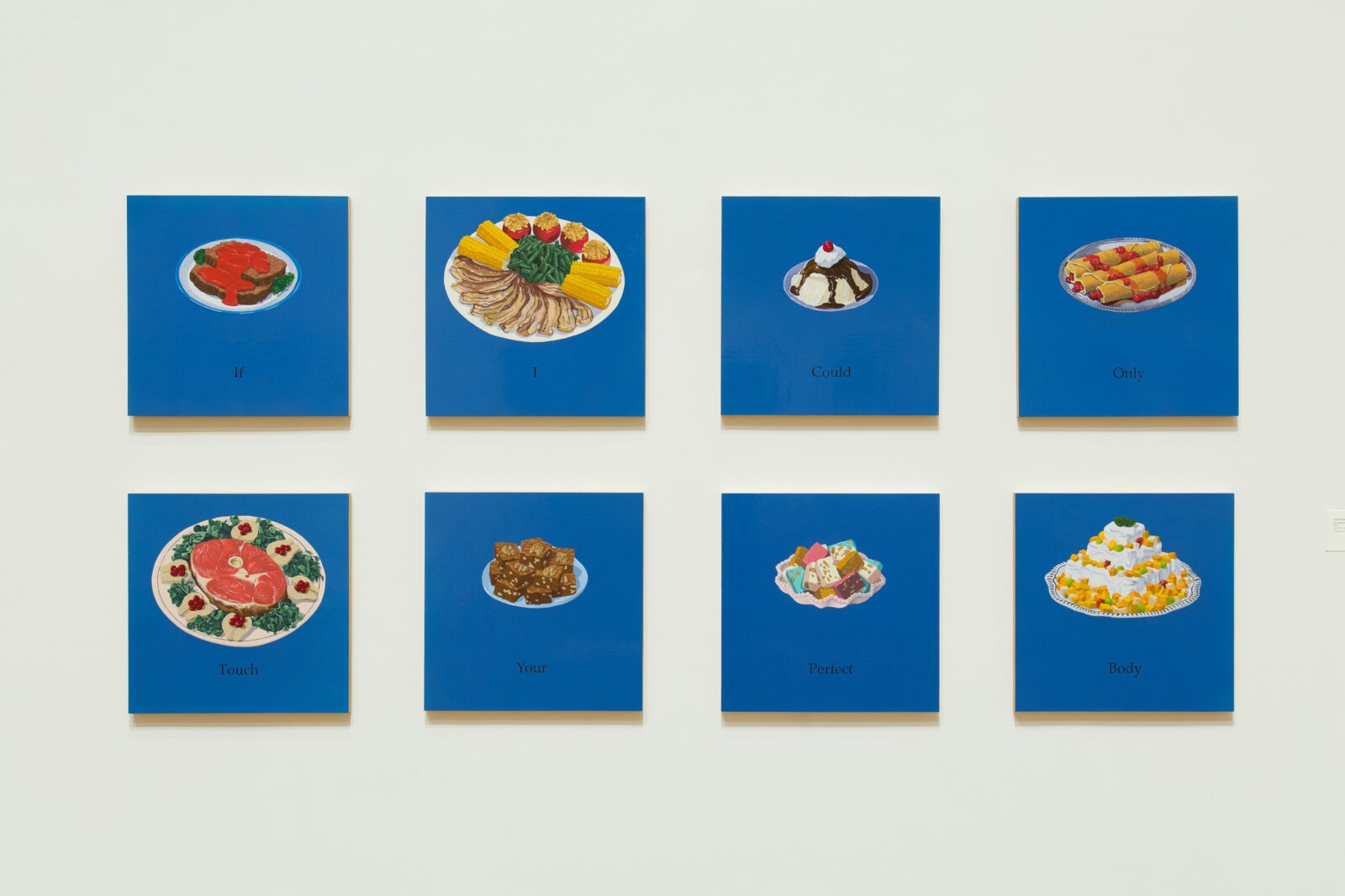
Lori Larusso’s painting “Imminent Danger” also involves the tension of a single moment to call attention to particular elements of food culture, specifically its relation to gendered labor and bodies. In the painting, Larusso depicts a three-layer yellow cake with a slice removed, decorated with white frosting, lines of piped red icing, and four miniature American flags, precariously perched on the edge of a kitchen counter, teetering over a garbage can. Yet, like Jacquette’s piece, there’s an ambiguity about what might be the actual danger suggested in the title. The fall of the cake is one perceived imminent danger, further underscored by Larusso’s use of foreshortening to create a steep angle to the countertop. In this case the danger would be the ruination of a considerable amount of effort, most likely that of a woman, since baking is, by and large, a gendered practice. Alternatively, the over-consumption of the cake is the possible danger, a danger more acutely felt by women given the societal expectations on women’s figures. Either way, by ruminating on this single instance of a cake on a counter, Larusso raises several issues around gender by looking at food.
While Jacquette’s and Larusso’s paintings focus on meticulously crafted individual dishes, several of the works in this exhibition explore the mass production of fast food. The ubiquity of American fast food is central to Steve Aishman’s 2007 photo series “Throwing Fast Food”. In this series, Aishman purchases and then tosses a recognizable menu item from a variety of fast food restaurants —a Nathan’s hotdog, sandwiches from Subways and Arby’s, a filet-o-fish from McDonalds, and a Frosty from Wendy’s—capturing the ensuing flight in a single still frame. There is humor in the precariousness in which these items appear; they fly through the air about to cause a mess that has not yet happened, spilling their contents as they go as if they are engaged in some kind of slapstick pratfall. At the same time, seeing these items separate into component parts midair makes these foods rather unappetizing and even inedible, and yet these items comprise a large portion of the American diet.
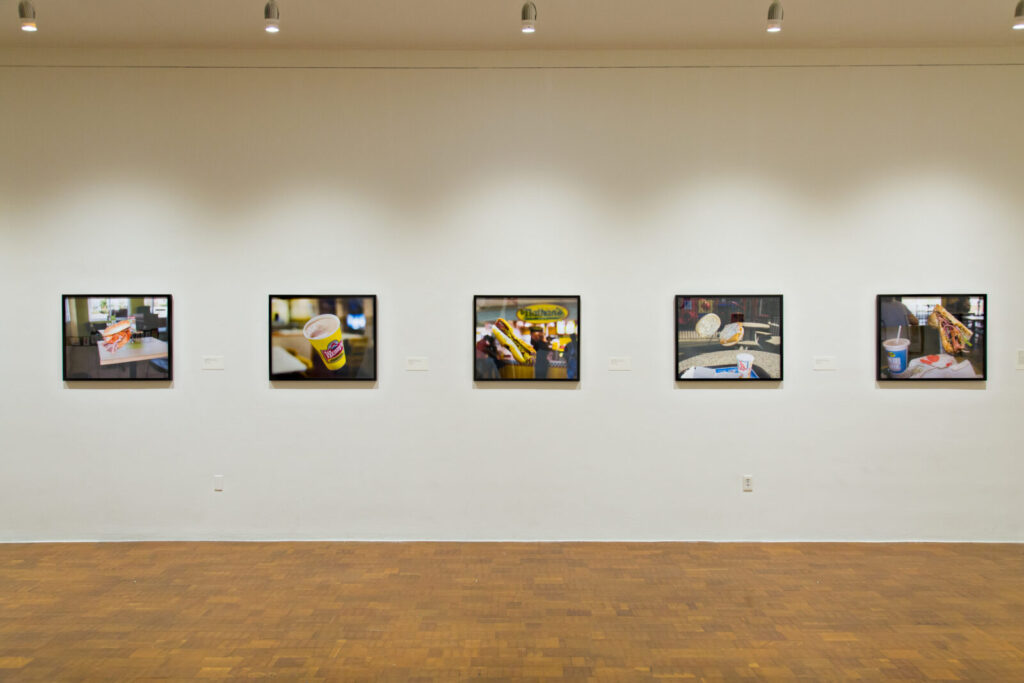
Sally Davies’ “Happy Meal Project” takes this rumination further, ultimately challenging the notion that these items are even food to begin with. For this on-going project, Davies purchased a Happy Meal from her local McDonalds on April 10, 2010, and has continued to photograph said Happy Meal daily for the last 9 years. Over that time, the meal has neither degraded nor decayed, as is natural for all foodstuffs. Instead, it has continued to look the same, day after day, year after year. Davies project of documenting the progress of this single burger and kid-sized fries, has drawn considerable media attention overtime, and an assortment of stills of the omnipresent meal are presented below a row of media clippings about Davies’ project. That the burger remains the same and media attention keeps returning to Davies’ documentation of it speaks to the staying power—both literal and figurative—of fast food within the American diet; even though it is clear from the documentation that this Happy Meal is, at the very least, full of preservatives, and, at worst, not food at all, McDonalds still persists as a mainstay of food culture in the U.S.
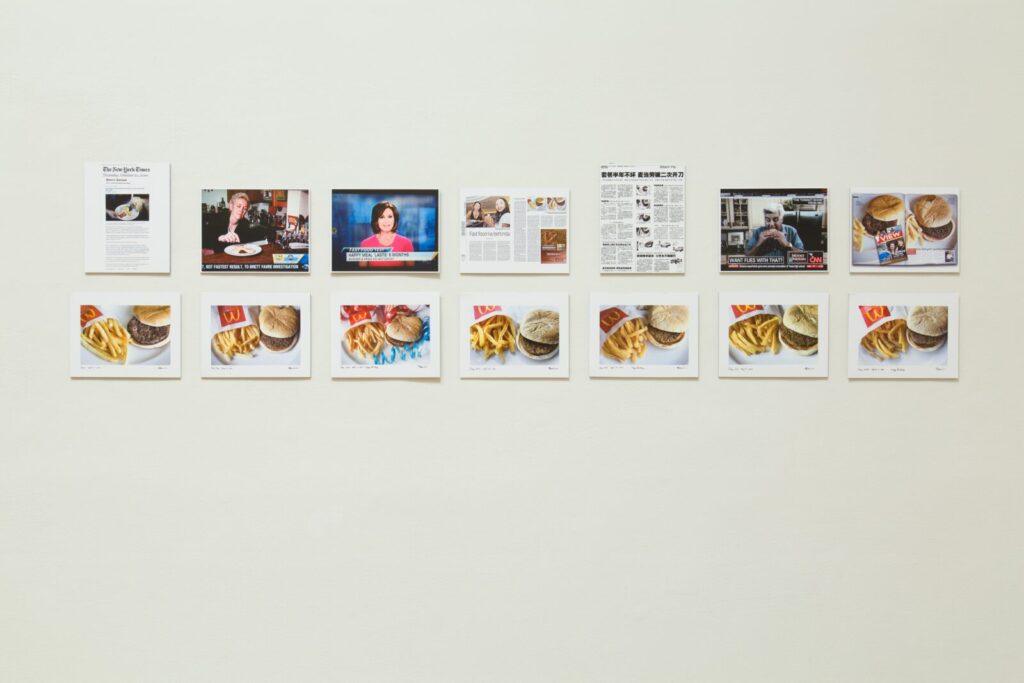
In addition to exploring shifting diets in the form of historical and present dishes (or in the case of Davies’, past meals persisting in the present), “Off the Menu” also considers how tastes change over the life of an individual by focusing on the preferences of children. For instance, Jennifer Coates’ painting “PBJ” focuses on the ubiquitous childhood staple of the peanut butter and jelly sandwich. Coates enlarges the form of the sandwich and depicts it open face—or more likely in mid-construction—highlighting the smearing together of the two viscous substrates that form the basis of the dish. In so doing, she renders the sandwich as a painterly and almost abstract image, making the tactility of the process of spreading peanut butter and jelly on a slice of bread almost palpable. The shift in scale and the attention therefore afforded to it, provides the audience with the opportunity to consider this simple and commonplace meal, allowing us to consider all the ways in which we have engaged with PB&J as cooks and eaters, adults and children.
This attention to the eating patterns of children is further explored in the section of the gallery dubbed “Kid’s Table,” which brings together work by local children under the guidance of Jarah Jones at ArtPlay and Georgia Henkel at Sayre School. These projects include drawings, paintings, and sculptures of particular foods done either individually or collaboratively, as well as a project wherein students constructed their own imagined restaurants out of boxes and other craft supplies. For the latter project, students also created menus for their restaurants, often including mainstays of childhood like pizza, pasta, and ice cream. Taken together, these projects serve as a reminder of the origins of our tastes as eaters and highlight the fact that food consumption is a learned process.
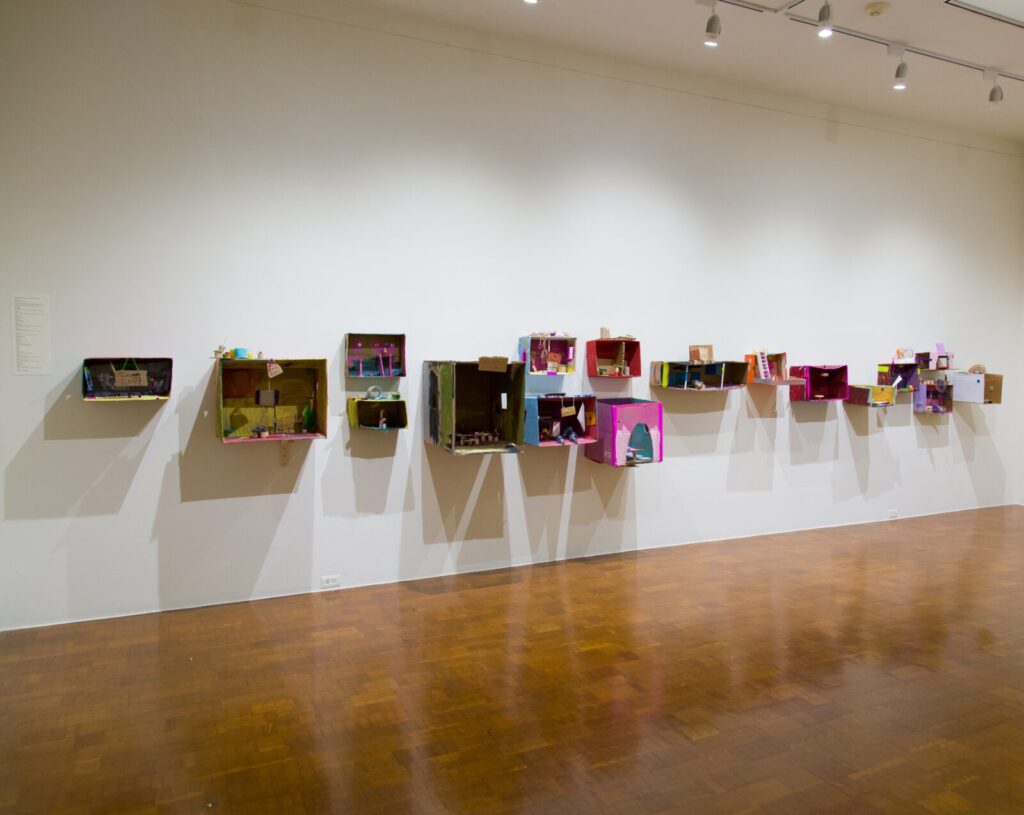
Moreover, the collaborative nature of these projects prompts us to remember the social and shared aspects of food practices in general. From the very beginning, we are dependent on others in order to eat and what and how we eat is deeply tied to the practices of our caretakers. While children are acutely aware of the power of food as a form of caretaking, as we get older we tend to forget that we began eating as a social exchange between ourselves and those who fed us. As such, this section allows us to consider more than simply what a chili pepper or a strawberry looks like when rendered by a child, but also to contemplate the multifaceted ways in which we have engaged with food over our lifetimes.
These are just a few of the myriad issues raised in “Off the Menu: Looking at Food.” Food’s position in our culture is so ubiquitous and our relationships to food practices are so complex and multifaceted that it is impossible to fully ascertain all of them in a single exhibition. That said, this show makes a clear effort to incite deeper thought and reflection on the subject of foodways than we typically allow in our daily interactions. By stopping to look at food, and literally regarding what we eat, we can see how the substances that nourish us reflect our broader social and cultural identities. Through this exhibition, we get a glimpse at the various forces that shape our consumption, be they historical antecedents, the ubiquity of fast food, or the process of learning to eat in the first place.




